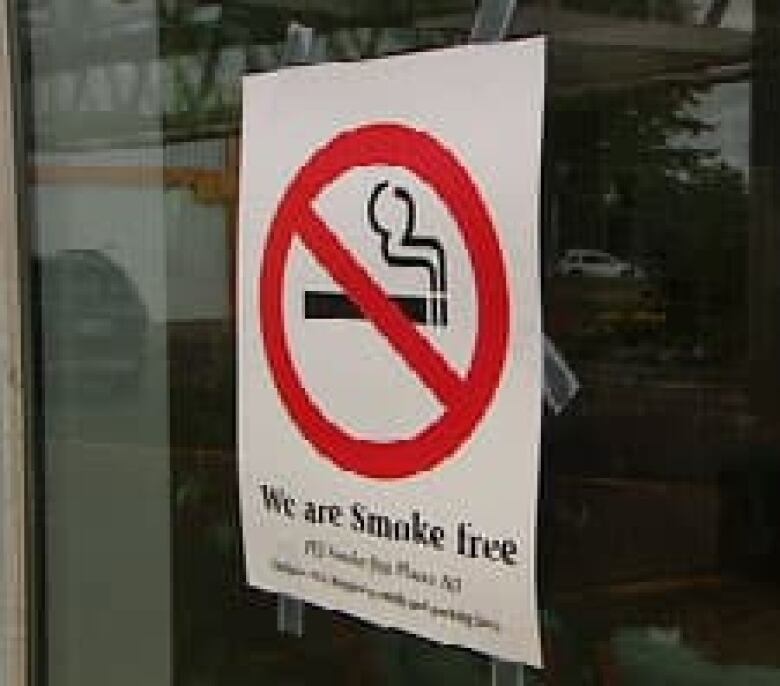Anti-smoking efforts in Canada and abroad

Day by day, smoking is becoming a thing of the past in Canada. The number of smokers has fallen, in tandemwith an increase in efforts by government and health activists to tighten up restrictions on the sale and use of tobacco.
Smoking has been banned from most offices for some time, but the bans have now extended to bars, restaurants and other public places. Some cities have made lighting up indoors entirely illegal.
Many jurisdictions have alsostarted totarget smoking in areas that were once considered private.
With the exception of Quebec, Alberta and the Northwest Territories, it is illegal to smoke in any vehicle that is carrying a child.
Several provinces, moreover, have begun legal proceedings or announced their intention to do so against tobacco companies to recover smoking-related health-care costs. The list includes British Columbia, Quebec, Newfoundland and Labrador, Nova Scotia and Manitoba.
The lawsuits are aimingfor big money, too. Ontario, for instance, is seeking $50 billion in damages for past and ongoing health-care costs.
The tobacco industry has argued that the federal government is responsible for some of these costs for allowing the sale of tobacco products and earning tax revenue from it.
However, the Supreme Court of Canada ruled on July 29, 2011, that thefederal governmentcannot be held liable in these lawsuits,
Canada is considered to beat the forefront of anti-smoking legislation, but the rest of the world is beginning to catch up. Here's a sampler of homegrown and global anti-smoking measures:
Efforts in Canada
Newfoundland and Labrador
The province's Smoke-free Environment Act was amended on July 1, 2005, to ban smoking in all public places, including bars and bingo halls. The law also prohibits smoking on restaurant decks or patios.
Smoking is allowed in specially designated rooms in pyschiatric facilities, long-term care facilities and workplaces, although the latteris open to staff only.
Prince Edward Island

On June 1, 2003, the Smoke-Free Places Act came into effect, prohibiting smoking in public places on the island.
The provincial goverment has also moved to strengthen the restrictions, banning smoking in designated rooms and making it illegal to smoke in a car with people under the age of 19.
Smoking is still allowed in nursing homes and community care centres and on patios or decks of eating establishments between 10 p.m. and 3 a.m.
Nova Scotia
Halifax regional council unanimously adopted a policy in October 2009 to restrict smoking at about 480 outdoor venues where children are present, such as parks, rinks and sports fields.
Smoking in public spaces was banned provincewide after Dec. 1, 2006, with a minimum fine of $2,000 for those who choose to light up. The only exceptions are designated rooms in nursing homes and long-term-care facilities.
Prominent displays of tobacco products in stores are also prohibited under the act.
Taxi cabs, bowling alleys, schoolyards and other public places were smoke-free as of Jan. 1, 2003. In bars and restaurants, smoking is restricted after 9 p.m. to an enclosed room that's separately ventilated and available only to adults. As well, tobacco can be seized from people under 19.
Nova Scotia has bannedsmoking in prison. In April 2008, the province also outlawed smoking in vehicles carrying children.
New Brunswick
As of October 2004 there has been a provincewide ban on smoking in all public areas. Restaurants and bars can't have smoking sections or glassed-in smoking areas.
Lighting up in a car with children present is also prohibited.
Quebec

Restaurants, bars, clubs, bingo halls, casinos and shelters became smoke-free on May 31, 2006. Smoking is also forbidden within nine metres of any doorway leading to a health or social services institution, college, university or child-care facility.
All private designated smoking roomswere eliminated by May 30, 2008.
It's illegal to sell tobacco by mail order, over the internet, on school grounds or in health-care, social services or child-care facilities.
Ontario
Retail behind-counter displays of tobaccowere banned after 2008. In 2009, Ontario also outlawed smoking in vehicles carrying children.
On June 1, 2006, the Smoke-Free Ontario Act prohibited smoking in all workplaces and enclosed spaces open to the public, except for private homes and hotel rooms.
By the numbers
- Five per cent of the world's population is protected by comprehensive smoke-free laws.
- Tobacco use has been linked with one in 10 deaths among adults worldwide.
- About21 per cent of Canadians were smokers in 2010.
- Smoking prevalence among Canadians 25 and older dropped from 19 per cent in 2007 to 17 per cent in 2008.
In Toronto in 2004, all bars, pool halls, bingo halls, casinos, and racetracks became smoke-free, with fines ranging from $205 to $5,000. A plan to outlaw smoking rooms by 2005 was sent back to council for review.
The Northwestern (Ontario) Health Unit banned smoking in all public places and private businesses as of Jan. 1, 2003, with fines ranging from $5,000 to $25,000.
The City of Ottawa banned smoking in all workplaces and public spaces, with no allowance for designated smoking rooms, on Aug. 1, 2001.
It's illegal to sell tobacco at hospitals, psychiatric facilities, nursing homes, long-term-care facilities and charitable institutions.
Manitoba
The Non-Smokers' Health Protection Act banned smoking in public areas, with the exception of group-living facilities and hotel rooms, as of October 2004. Restaurants and bars can't have smoking sections or glassed-in smoking areas.
As of January 2002, it becameillegal to smoke in any indoor location in Winnipeg where minors are present. Some coffee shops and restaurants avoid this problem by banning children.
All public places in Winnipegbecame smoke-free as of Sept. 1, 2003.
Saskatchewan
Saskatchewan in 2009 outlawed in all enclosed places of employment, including offices, warehouses, vehicles and some mines.
On Jan. 19, 2005, the Supreme Court of Canada ruled the province could reinstate the "shower curtain law" that requires store owners to keep tobacco products out of sight.
As of January 2005, all public places, including outdoor areas and veterans' clubs, became smoke-free under the Tobacco Control Act, with fines of up to $10,000 for smokers who violate it.
In August 2010, the provincial government banned smoking near schools as well.
Alberta

The provincial government moved to restrict smoking in public in 2006 but since2009, the Tobacco Reduction Act has prohibited smoking in all publicareas and workplaces.
It is also illegal to advertise or promote tobacco products and the sale of products is outlawed in health-carefacilities, pharmacies andpublic post-secondary schools.
People under age 18 who are caught smoking or in possession of tobacco products after April 1, 2003, can be fined $100 and have their cigarettes seized.
Some Alberta communities have also tried to restrict smoking laws. For instance, smoking in cars where children are present was banned in Leduc in July 2011.
British Columbia
In 2009, British Columbia outlawed citizens from lighting a cigarette in a vehicle in the presence of a person under the age of 16. A provincewide ban on smoking in public placesbegan in2008.
You can't smoke in public places like restaurants, bars, bingo halls, bowling alleys and casinos. Restaurant and bar owners may construct open smoking rooms.
Some communities have also moved to beef up anti-smoking laws.
Victoria banned smoking in all indoor public spaces on Jan. 1,1999.It is also illegal to smoke in a public park in Vancouver.
Yukon
In May 2008, the Yukon became the last of the provinces and territories to ban smoking in public places.
Northwest Territories
In March 2006, legislationwas passed confirming and enforcing the Workers Compensation ban on smoking in workplaces.
| World Health Organization |
| WHO report suggests 1B people may die from tobacco in 21st century. (PDF, Feb. 2008) |
The Workers Compensation Board bans smoking in all enclosed businesses and work sites on May 1, 2004, including bars. Smoking rooms are only allowed in workplaces that are private residences.
Nunavut
Smokingwas banned in all enclosed businesses and work sites on May 1, 2004, by the Workers Compensation Board. This includes bars. It also bans smoking within 15 metres of schools and three metres of entrances.
Notable anti-smoking efforts around the world
- The Himalayan kingdom of Bhutan in December 2004 became the first country in the world to ban all tobacco sales and smoking in public.
- In March 2004, Ireland became the first country to institute a total ban on smoking in all workplaces, including the country's more than 10,000 pubs.
- China banned smoking in all indoor public places in May 2011 but some reports said the vaguely defined rules were unlikely to reduce the number of people lighting up.
- New York City outlawed smoking in parks and beaches even Times Square in February 2011..
- Italy introduced legislation on Jan. 10, 2005, to ban smoking in public places. It was originally expected to take effect Dec. 31, 2004, but legislators decided to allow smokers to light up on New Year's. Restaurant and bar owners said they were upset that they will be required to report their customers if they break the law.
- In May 2001, the European Union gave its final approval to legislation that would ban the use of the terms "light" and "mild" for advertising cigarettes, and allow for graphic pictures of diseased lungs and hearts on cigarette packs.
- In March 2001, Israel banned smoking in public places, including hospitals, shopping malls and restaurants.
- In April 2001, health officials from eight Asian countries Indonesia, Thailand, India, Bangladesh, Burma (also known as Myanmar), Nepal, Bhutan and Sri Lanka agreed to support a proposal to totally ban cigarette advertising.
- In February 2001, Russia's Duma gave preliminary approval to bills banning tobacco ads in print media, on street billboards and in public transportation. They were already banned from television.
Restaurants and bars invariably predict sales will plummet once a smoking ban is put in place. In Ireland, a month after the ban went into effect, the government's Office of Tobacco Control reported that 97 per cent of inspected pubs and restaurants were complying with the law. It also cited two studies which suggested that the number of non-smokers visiting pubs and bars had increased, while the number of smokers doing so had remained the same.
A day later, the main bar owners' association cited a study of its own. It suggested sales had fallen 12 to 15 per cent. But Ireland's restaurant association reported sales were about the same as they were a year earlier.












_(720p).jpg)


 OFFICIAL HD MUSIC VIDEO.jpg)
.jpg)



























































































